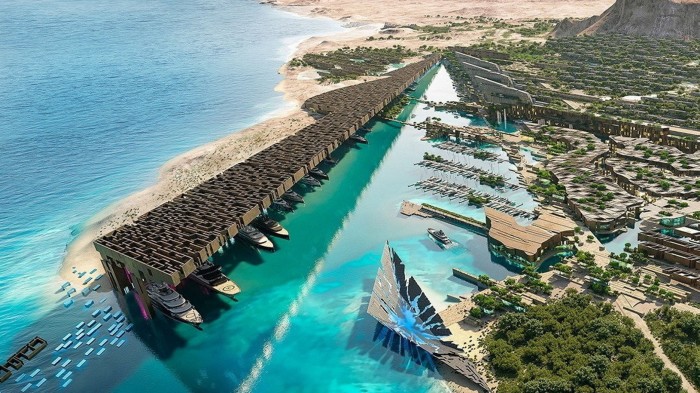Weak oil prices are adding to pressure on Saudi Arabia’s vast spending programme as Riyadh prepares to unwind crude production cuts starting on Tuesday, which is likely to push prices lower.
Economists said the kingdom would probably need to slash expenditure by more than the 3.7 per cent annual drop planned for 2025, as oil prices linger near $70 a barrel — far below the level that would help the country balance its books — and state-owned giant C cuts dividends.
The squeeze comes as Saudi Arabia pursues ambitious projects scheduled to cost hundreds of billions of dollars, including the flagship Neom city scheme, as part of Crown Prince Mohammed bin Salman’s plan to transform the economy.
“A sharper and sustained fall in the oil price would require a deeper retrenchment in government spending to contain the size of the shortfall and the building in government debt,” said Monica Malik, chief economist at Abu Dhabi Commercial Bank.
“There would also likely be some further adjustment and recalibration to the off-budget investment plans.”
The government said late last year it planned to spend $342bn on projected revenues of $315bn in 2025, forecasting a budget deficit of about $26bn. The kingdom is already the biggest issuer of emerging market debt this year.

Some projects under the Saudi Vision 2030 plan set out in 2016, such as resorts in the Red Sea, have begun operations, but many others under construction, including the futuristic desert development Neom, have faced cuts and delays. Many projects are being carried out by Saudi Arabia’s Public Investment Fund, which is largely funded through oil revenues.
The kingdom also faces daunting deadlines to host major international events starting with the Asian Winter Games in 2029, followed by Expo 2030 and the football World Cup in 2034.
These will require prioritising spending for ambitious infrastructure projects, including building about 10 stadiums — one of which is set to be elevated 350 metres above ground — and a ski resort with a fresh water artificial lake and artificial snow.
Riyadh has already been recalibrating spending after a frenetic decade, delaying some projects and downsizing others because of subdued oil prices and fears about overheating the economy.
For the past three years, under energy minister Prince Abdulaziz bin Salman, Saudi Arabia sought to maximise oil revenues by holding back production to push crude prices higher. That was initially successful, with cuts by Saudi Arabia and other Opec+ members helping fund the kingdom’s spending by keeping crude above $90 a barrel for most of 2022.
But the cuts have become less effective, even though the kingdom is pumping at its lowest rate since 2011, apart from the coronavirus pandemic and the time of a 2019 attack on a major oil processing facility.
Demand growth has been weak, oil output has increased elsewhere and some Opec+ members have pumped above their quotas, resulting in benchmark crude prices dropping to a three-year low of $68 per barrel this month. The IMF last October projected the kingdom’s oil break-even price to be about $91 per barrel this year.
Saudi Arabia will now start unwinding some production cuts from April, along with seven other Opec+ members. The kingdom was no longer prepared to shoulder the biggest share of the cuts while other Opec+ members cheat, said people familiar with its thinking, and was prepared to endure lower oil prices as a result.
The shift in Saudi policy means a sustained period of lower oil prices is more likely, with most traders expecting crude to trade at current levels or lower for at least the rest of the year.
Aramco, which is owned by the Saudi government and the sovereign wealth fund, said this month it expected to declare total dividends of $85.4bn in 2025, a drop of almost a third from last year’s figure of more than $124bn.
Economists said the government was likely to maintain a tight fiscal policy while increasing borrowing as it boasts a debt-to-GDP ratio of 29.7 per cent, considered low for an economy of its size, and total foreign reserves of more than $430bn as of February.
Simon Williams, chief economist for Central and eastern Europe, the Middle East and Africa at HSBC, said that rather than the spot price, the important factor was “where oil prices settle through the cycle and what happens with output”.
“Non-oil revenue has risen, but spending has risen more quickly as the kingdom has stepped up its development plans,” he said. “And that inevitably means the budget is more oil-revenue reliant than it has been in the past.” Oil accounts for 61.6 per cent of government revenue, according to the 2025 budget.
The government said earlier this year it planned to raise $37bn to cover the budget deficit and outstanding debt maturities due in 2025. It has raised $18.4bn in debt so far this year, while the PIF and its subsidiaries have issued more than $5bn.
The IMF said in September the government should consider introducing a property tax and personal income tax, but Saudi officials said they were not looking at changing the tax regime.
S&P Global Ratings this month raised Saudi Arabia’s credit rating for the first time in two years to A+, signalling that reforms, including moves to boost non-oil income, were succeeding.
But the agency warned it could lower the rating if Saudi Arabia’s public finances weakened significantly as a result of debt.
It said: “This could be the case if we saw a combination of a sharp ramp-up in investment projects funded by debt, along with a slowdown in growth, higher borrowing costs, and unfavourable movements in oil prices.”
Additional reporting by Chloe Cornish in Dubai; data visualisation by Keith Fray
https://www.ft.com/content/631838c8-a86a-44d2-86cc-587288eb089f


